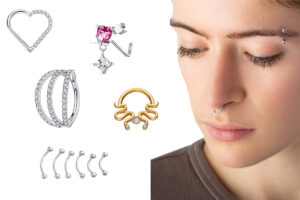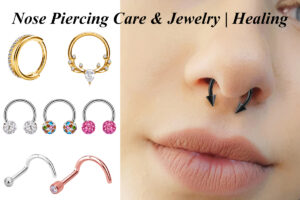Введение: Why Understanding Piercing Jewelry Quality Is Crucial
Для импортеров, selecting high-quality пронзительные украшения is essential not only for customer satisfaction but also for the brand’s reputation and compliance with safety standards. The quality of piercing jewelry directly affects the healing process of piercings, with low-quality jewelry potentially leading to infections, аллергические реакции, and other health risks. Therefore, knowing how to judge the quality of piercing jewelry is an essential skill for every importer.
This guide will comprehensively cover how to assess the quality of piercing jewelry, from material selection and surface finish to gemstone quality, manufacturing standards, and regulatory compliance. By understanding these key factors, importers can make smarter purchasing decisions and ensure they are offering safe, high-quality products to their customers.
Need more details? Свяжитесь с нами по адресу info@sensagem.com to get our full product catalog and material certification.
1. Understanding Materials: The Foundation of Quality Piercing Jewelry
Material Selection for Piercing Jewelry
High-quality пронзительные украшения is typically made from implant-grade materials such as titanium (ASTM F-136) and surgical stainless steel (ASTM F-138). These materials are widely regarded as the best options for piercing jewelry due to their strong biocompatibility, which helps to minimize allergic reactions and promotes quicker healing. For first-time piercings, titanium and surgical stainless steel are ideal choices as they are gentle on the skin and durable.
•Титан: This metal is not only lightweight but also highly resistant to corrosion, making it one of the most popular materials for piercing jewelry. It will not rust and can withstand high temperatures, which makes it ideal for sensitive skin.
•Хирургическая нержавеющая сталь: This material is relatively strong, долговечный, and more affordable, but still offers high biocompatibility, making it suitable for initial piercings.
The Importance of Material Quality
The material used in piercing jewelry plays a critical role in the healing process. Titanium and surgical stainless steel are unlikely to cause allergic reactions and support faster healing. С другой стороны, low-quality metals like plated gold or silver can cause allergic reactions, infections, or delayed healing.
For more detailed product information, Пожалуйста, свяжитесь с нами по info@sensagem.com.
You can also check out the Association of Professional Piercers’ recommendations for choosing safe, implant-grade jewelry for initial piercings.
2. Surface Finish and Safety: How It Affects Piercing Jewelry Quality
The Importance of Smoothness
The surface finish of piercing jewelry has a significant impact on both safety and comfort. Jewelry must have a smooth, flawless surface, free from scratches, nicks, or imperfections. These flaws can harbor bacteria and increase the risk of infection.
•Mirror Polishing: A mirror polish ensures the jewelry is smooth and reduces friction against the skin, minimizing irritation and discomfort. This is why most high-quality piercing jewelry is meticulously polished and finished.
The Risks of Poor Finish
Poorly finished jewelry can cause a range of problems. Например, rough edges or surfaces can tear the skin, leading to infections or inflammation. Moreover, poorly finished jewelry can attract dirt and bacteria, which will prolong the healing process and might lead to other complications.
3. Gemstone Quality: Cut, Clarity, and Setting
Evaluating Gemstone Cut and Clarity
For jewelry with gemstones, the cut and clarity are essential in determining both the aesthetic appeal and the durability of the piece. High-quality gemstones are cut with precision to enhance their brilliance and clarity, ensuring they contribute to the overall beauty and strength of the piercing jewelry.
•Cut: The quality of the cut affects how the gemstone reflects light. A well-cut gemstone will shine brightly, while a poorly cut gemstone may look dull or misshapen.
•Clarity: The higher the transparency and clarity of the gemstone, the more visually appealing it is. Low-quality gemstones may appear cloudy or full of inclusions, diminishing their overall appearance.
Setting Quality and Safety
The method used to set gemstones is equally important. High-quality jewelry will use secure settings, such as prongs or bezels, to ensure the gemstones are held firmly in place. Avoid using adhesives, which can degrade over time and cause the stones to loosen or fall out.
4. Manufacturing Standards and Compliance: Ensuring Safety
Understanding Industry Standards
Piercing jewelry must adhere to specific manufacturing standards to ensure its safety and quality. Importers should verify that their suppliers meet these standards, such as those set by the Association of Professional Piercers (APP) or other regulatory bodies. These organizations establish the guidelines to guarantee that jewelry is safe for use and can withstand the healing process.
•APP Certification: APP certification is an important indicator of piercing jewelry quality. It signifies that the jewelry has undergone rigorous testing and meets the highest standards for safety and durability.
The Importance of Certification
Certification is a crucial way to determine the quality of piercing jewelry. High-quality jewelry will often be certified, demonstrating that it has passed various quality checks and complies with safety regulations. Importers should prioritize working with suppliers that provide certification, as this ensures they are purchasing products that meet industry standards.
5. Jewelry Quality Testing: Ensuring the Jewelry Meets Standards
Common Quality Testing Methods
To ensure piercing jewelry is of the highest quality, suppliers perform various tests. К ним относятся:
•Visual Inspections: Inspecting jewelry for defects, such as scratches, cracks, or other surface flaws.
•Pull Tests: Testing the strength of the jewelry to ensure it can withstand normal wear without breaking.
•Chemical Analysis: Confirming the purity of metals used to manufacture the jewelry to ensure they are free from harmful substances.
Using Proper Testing Equipment
Suppliers should employ professional testing equipment to verify that each piece of piercing jewelry meets safety and quality standards. As an importer, it’s essential to inquire about the quality control procedures used by suppliers before placing an order.
6. Common Defects to Avoid in Piercing Jewelry
Identifying Defects and Their Impact
Common defects in piercing jewelry include:
•Scratches and Flaws: Jewelry with scratches or visible imperfections can harbor bacteria and lead to infections or delayed healing.
•Poor Assembly: Jewelry that is poorly assembled may break, causing discomfort and health risks.
•Loose Gemstones: If gemstones are not securely set, they can fall out or become damaged, affecting the appearance and function of the jewelry.
How to Avoid Defects
Importers should regularly check jewelry for defects before purchasing and consider working with trusted suppliers who maintain strict quality control processes. Ensuring that jewelry is defect-free will help prevent customer complaints and ensure the product’s safety.
7. Consumer Safety: Regulatory Considerations
Legal Compliance
Piercing jewelry must comply with local and international safety regulations. Different countries have their own laws regarding piercing jewelry, and importers must ensure they are adhering to these regulations.
Ensuring Consumer Safety
It is the responsibility of the importer to ensure that the jewelry complies with relevant health and safety standards. Only jewelry that meets these regulations can guarantee consumer safety and minimize the risk of infection or allergic reactions.
8. Market Trends: What Importers Need to Know About Piercing Jewelry Quality
Current Trends in Quality
As consumers become more aware of the importance of jewelry quality, the demand for implant-grade materials is increasing. More and more customers are opting for high-quality piercing jewelry, especially for initial piercings, due to its enhanced safety and durability.
Meeting Market Demand
Importers should stay informed about market trends and ensure they are sourcing products that meet consumer expectations for high-quality piercing jewelry. Offering top-tier products will help build trust with customers and differentiate the importer from competitors.
9. Frequently Asked Questions About Piercing Jewelry Quality
1. What materials are best for piercing jewelry?
• Titanium and surgical stainless steel are the best choices for piercing jewelry due to their biocompatibility and durability.
2. How can I tell if my piercing jewelry is high quality?
•Look for smooth finishes, secure gemstone settings, and certifications from reputable suppliers.
3. What are the risks of using low-quality piercing jewelry?
• Low-quality jewelry can lead to allergic reactions, infections, and delayed healing due to poor material choices.
4. How does the surface finish affect piercing jewelry?
• A smooth, polished surface reduces friction, preventing irritation and minimizing the risk of infection.
5. Are there specific standards for body jewelry manufacturing?
• Yes, manufacturers should comply with industry standards such as those set by the APP to ensure safety and quality. You can read more about these standards здесь.
Заключение: How to Choose High-Quality Piercing Jewelry
By following the guidelines provided in this article, importers can better understand how to assess the quality of piercing jewelry. From material selection and surface finish to gemstone quality and compliance with industry standards, these factors play a crucial role in ensuring the safety and satisfaction of customers. Working with certified, high-quality suppliers will ensure that the products you offer are safe, долговечный, and meet the demands of the modern market.
For further inquiries or to get our full product catalog and material certificates, contact us at info@sensagem.com.







